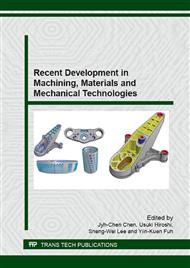p.391
p.398
p.404
p.410
p.416
p.422
p.428
p.434
p.440
A Novel Tape and Diamond Process Developed for Polishing Hard Substrates
Abstract:
A nanoscale polish process with improved desired characteristics of low roughness and low scratch counts has been developed using a novel polish tape and diamond abrasive on hard glass substrates. For an improved polishing performance with high removal rate properties and preventing scratches, a novel tape was developed having a nanofiber level, densified surface and a flatter surface by slenderizing the fiber and dispersing ultrafine fiber using an innovative technique. Using this novel polishing tape with a fiber size of 200nm, one can produce a 17% lower surface roughness (Ra) (from 1.05A to 0.87A) and a reduced polished surface scratch count of 53 reduced to 18. The novel nanocluster diamond abrasive is synthesized from carbon atoms of explosives created by detonation in a closed chamber under an oxygen leaked atmosphere ambient. Several crystals are bonded together by layers of non-diamond carbon and other elements, forming aggregates with a nanocluster structure. Using this novel nanocluster diamond along with an ultra-fine diamond mixture with a nominal size of 15nm, one is able to produce an improvement of a 48% lower surface roughness Ra (from 0.87A to 0.45A) and a lower polishing surface scratch count reduced from 18 to 7. Overall, these results indicate that a smoother and a reduced scratch polished substrate results in a significant improvement in disk defects and related magnetic performances.
Info:
Periodical:
Pages:
416-421
Citation:
Online since:
July 2015
Authors:
Keywords:
Price:
Сopyright:
© 2015 Trans Tech Publications Ltd. All Rights Reserved
Share:
Citation:


